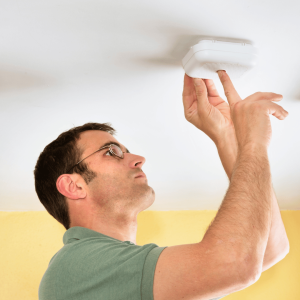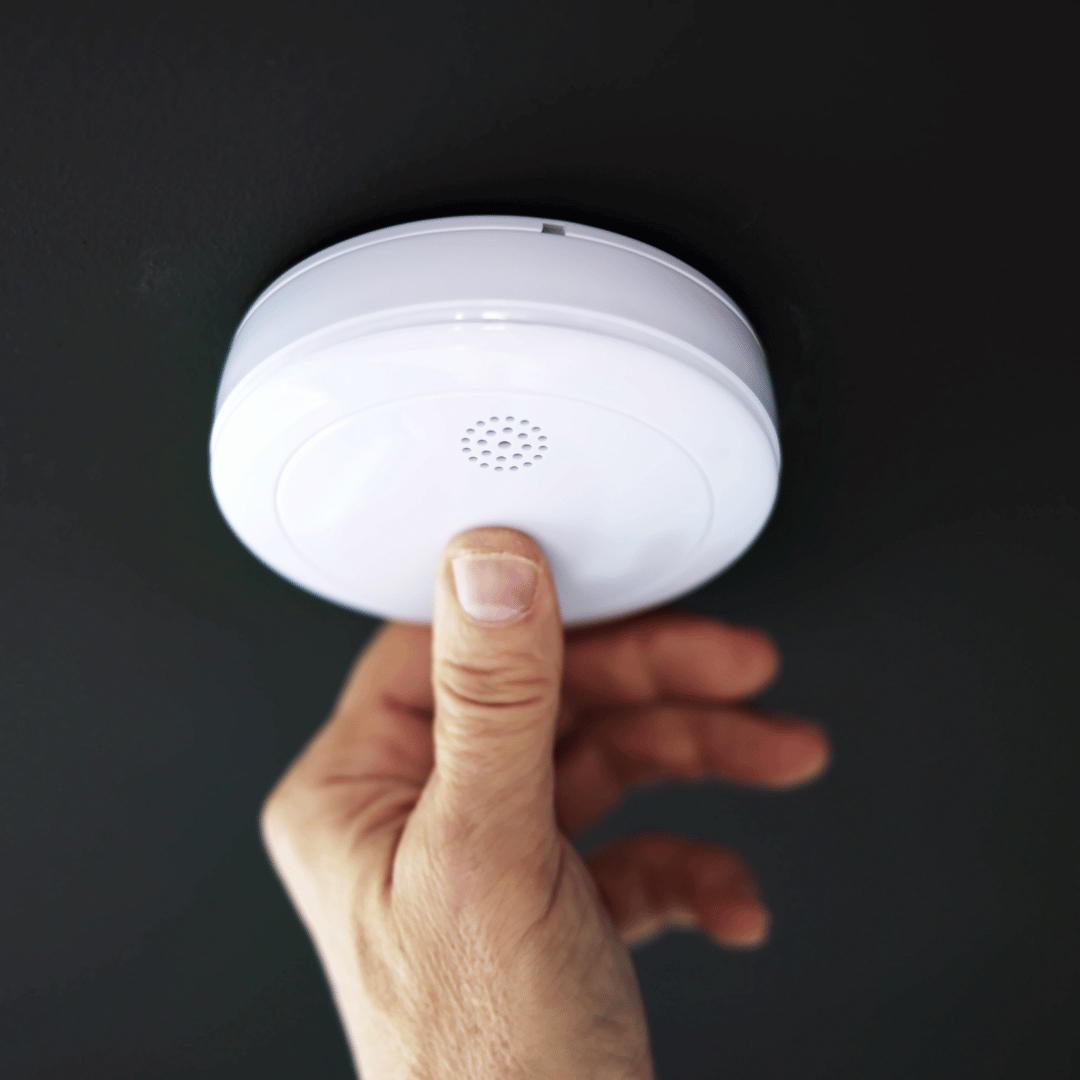
Maximize Safety with Ceiling Smoke Detectors: Installation and Maintenance Tips
At HomeSmiles, we believe that a safe home is a happy home. As a preventative home maintenance service provider, we understand the critical role that smoke detectors play in safeguarding your family and property. Among the various types of smoke alarms, ceiling smoke detectors are particularly effective due to their strategic placement.
In this article, we will explore essential information about ceiling smoke detectors, including their proper installation, maintenance, and why they are vital for fire safety. By following the guidelines and recommendations outlined here, you can ensure your home remains protected against the threat of fire, ultimately providing peace of mind for you and your loved ones.
Let’s dive into everything you need to know about ceiling smoke detectors and how they can enhance your home’s safety.
Should Smoke Alarms Be Installed on the Ceiling?
Yes, smoke alarms should ideally be installed on the ceiling. The primary reason for this recommendation is that smoke rises. In the event of a fire, smoke will ascend to the highest point in the room, making the ceiling the optimal location for smoke detectors to detect any potential danger quickly.
Benefits of Ceiling Installation:
- Faster Detection: Ceiling-mounted smoke detectors can respond more swiftly to smoke, increasing the chances of early warning. This early detection can be crucial in providing you and your family with additional time to evacuate and seek safety.
- Unobstructed Airflow: Installing smoke alarms on the ceiling ensures they are free from obstructions that could hinder their effectiveness, such as furniture, drapes, or other household items. This unobstructed position allows for better airflow and enhances the detector’s ability to sense smoke particles.
- Space Efficiency: Ceiling installations help keep smoke detectors out of the way, minimizing the risk of accidental damage or interference from daily activities. This placement also helps maintain the aesthetic appeal of your home without compromising safety.
In summary, installing smoke alarms on the ceiling is a practical choice that maximizes their effectiveness, ensuring your home is better protected from fire hazards.
Where Should Smoke Alarms Be Located When Installed on the Ceiling?
When installing smoke alarms on the ceiling, proper placement is crucial for maximizing their effectiveness. Here are some important guidelines to follow:
1. Recommended Distance from Walls
- At Least 4 Inches Away: Smoke alarms should be installed at least 4 inches away from any wall. This distance allows smoke to circulate freely around the detector, preventing dead air pockets that can delay activation.
2. Coverage in Bedrooms and Living Areas
- Every Sleeping Area: Install smoke detectors in every bedroom to ensure that everyone can hear the alarm while sleeping.
- Outside Sleeping Areas: A smoke alarm should also be placed outside each sleeping area (e.g., in hallways) to alert occupants if a fire starts while they are in their rooms.
- On Every Level: It is essential to have a smoke detector on every level of the home, including the basement and attic, to provide comprehensive coverage.
3. Importance of Avoiding Obstructions
- Distance from Vents and Fans: Keep smoke detectors away from heating or cooling vents, fans, or windows, as airflow can interfere with smoke detection and cause false alarms.
- Avoid High Humidity Areas: Areas like bathrooms should be avoided, as steam from showers can lead to unnecessary alarms. Instead, position the detectors in nearby hallways.
By following these placement guidelines, you can ensure that your ceiling smoke detectors are strategically located to provide optimal coverage and effectiveness, enhancing the overall safety of your home.
How Do I Turn Off the Smoke Detector on My Ceiling?
At some point, you may need to turn off your ceiling smoke detector, whether due to a false alarm or to conduct maintenance. Here’s how to safely and effectively turn off your smoke detector:
1. Identify the Type of Smoke Detector
Before proceeding, determine whether your smoke detector is battery-operated or hardwired. This will affect the steps you need to follow.
2. Silencing the Alarm
Most smoke detectors come with a “silence” button designed to temporarily mute the alarm. To silence the alarm:
- Locate the Button: Find the silence button on your smoke detector.
- Press and Hold: Press and hold the silence button for a few seconds. This should stop the alarm for a limited time, allowing you to address the situation.
3. Powering Off the Detector
If you need to completely power off the detector (for maintenance or if it continues to sound):
- Battery-Operated Detectors:
- Open the battery compartment, usually located on the side or back of the unit.
- Remove the battery to turn off the smoke detector completely.
- Hardwired Detectors:
- Turn off the power at the circuit breaker that controls the smoke detector.
- You may need to consult the unit’s manual for specific instructions on safely disconnecting it from the electrical supply.
4. Resetting the Detector
After resolving the cause of the alarm or replacing the battery, it’s important to reset the smoke detector to ensure it functions properly:
- Press the Reset Button: Most detectors have a reset button. Press it to re-enable the alarm.
- Test the Alarm: Conduct a test by pressing the test button to ensure the detector is functioning correctly.
By knowing how to effectively turn off and reset your ceiling smoke detector, you can maintain its functionality and ensure the safety of your home. Regular checks and maintenance of smoke detectors are key components of preventative home maintenance and help avoid potential safety hazards.
Why Put a Smoke Alarm on the Ceiling?
Installing smoke alarms on the ceiling is a crucial safety measure for any home. Here are some compelling reasons to prioritize ceiling installation:
1. Effective Smoke Detection
Smoke rises due to its lower density compared to air. By placing smoke alarms on the ceiling, you ensure that they are positioned to detect smoke as soon as it enters the atmosphere. This placement allows for a quicker response time in the event of a fire, providing valuable seconds that can be critical for escape and safety.
2. Comprehensive Coverage
Ceiling smoke detectors provide better coverage in larger spaces, such as open-plan living areas. Their elevated position helps them monitor a broader area, ensuring that smoke is detected regardless of where a fire might start within the room. This comprehensive coverage can significantly enhance the overall safety of your home.
3. Reduced False Alarms
By installing smoke detectors on the ceiling, you can minimize the likelihood of false alarms. Smoke detectors placed too close to walls or in areas with high humidity (like bathrooms) are more prone to trigger unnecessary alarms. Ceiling placement helps avoid these common pitfalls, leading to fewer disturbances and greater trust in the alarm’s reliability.
4. Space Efficiency
Ceiling smoke alarms are out of the way, reducing the chances of accidental damage or interference during daily activities. They also blend seamlessly into the room’s design, allowing you to maintain an uncluttered and aesthetically pleasing environment without compromising safety.
5. Enhanced Safety Features
Many modern ceiling smoke detectors come equipped with advanced safety features, such as photoelectric sensors and interconnectivity with other alarms. This means that if one alarm detects smoke, all connected alarms will sound, providing a more robust warning system throughout the home.
In summary, placing smoke alarms on the ceiling is a best practice that enhances their effectiveness and contributes significantly to the safety of your home. Regular maintenance, including testing and battery replacement, is essential to ensure these devices work as intended, forming a crucial part of your interior home maintenance routine.
Where Should Smoke Detectors Not Be Installed?
While proper placement of smoke detectors is essential for safety, it’s equally important to know where not to install them. Certain locations can hinder the detector’s performance, leading to delayed responses or false alarms. Here are some areas to avoid when installing smoke detectors:
1. Kitchens
- Reason: Cooking fumes, steam, and heat can easily trigger false alarms.
- Recommendation: It’s advisable to install smoke detectors at least 10 feet away from cooking appliances to minimize unnecessary disturbances while still ensuring adequate coverage.
2. Bathrooms
- Reason: High humidity levels from showers can cause steam to activate the alarm, leading to false alarms.
- Recommendation: Avoid placing smoke detectors in bathrooms altogether. Instead, install them in nearby hallways or common areas.
3. Near Air Vents and Fans
- Reason: Airflow from heating and cooling vents can disrupt the smoke detection process, delaying alarm activation.
- Recommendation: Smoke detectors should be installed at least 3 feet away from any air vents to ensure that they can accurately detect smoke without interference.
4. Dusty or Dirty Areas
- Reason: Dust and dirt can accumulate in smoke detectors, potentially leading to malfunctions or false alarms.
- Recommendation: Avoid installing smoke detectors in dusty environments, such as workshops or garages. Regular maintenance, including cleaning, is essential for optimal performance.
5. Near Bedrooms with Open Windows
- Reason: Open windows can lead to drafts that may carry smoke away from the detector, hindering its ability to respond effectively.
- Recommendation: Ensure that smoke detectors in or near bedrooms are positioned away from open windows and other sources of drafts.
By steering clear of these problematic areas, you can maximize the effectiveness of your ceiling smoke detectors, ensuring that they provide reliable protection for you and your family. This strategic placement is a key element of your home safety strategy and contributes to overall preventative home maintenance.
In conclusion, ceiling smoke detectors are essential for protecting your home from fire hazards. By strategically placing them on the ceiling, you ensure quick and reliable detection of smoke, giving you and your family crucial time to respond in an emergency. Understanding where to install these devices—and where not to—is key to maximizing their effectiveness.
At HomeSmiles, we believe that a proactive approach to interior home maintenance is vital for the safety and longevity of your home. Regular checks and maintenance of your smoke detectors are just a few steps in our extensive 18-point home maintenance service, designed to keep your home safe, functional, and efficient.
Take action today! If you haven’t already, test your smoke detectors and check their installation locations. For a thorough home maintenance check, including smoke detector assessments and more, contact HomeSmiles today. Let us help you tackle those “honey-do” items so you can enjoy peace of mind knowing your home is safe and secure.
Schedule your preventative home maintenance service now!
- Protecting Your Property: Why the Right Cleaning Method Makes All the Difference
- The #1 Thing That’s Dulling Your Curb Appeal (And How to Fix It)
- How Maintenance Bundles Provide Peace of Mind for Busy Small Business Owners and Facility Managers
- Essential vs. Complete Home Packages: Choosing the Right Preventive Care for Your Property
- How a Simplified Service Model Benefits Both Homeowners and Franchisees Alike


